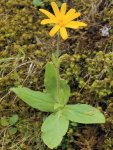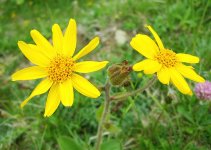Arnica mountain - arnica montana l.
Family Asteraceae - Compositae
Botanical characteristics. Perennial herbaceous plant up to 60 cm tall. It grows in pine forests, forests, glades, glades, dry and high-mountain meadows.
Rhizome is horizontal thin with numerous additional roots. At the ends of the rhizome are located pressed to the ground rosettes of 6-8 dense elliptical or oblong-ovate leaves. The stems are not very leafy, only 1-2 pairs are much smaller than the root sedentary with rare teeth of the leaves. Flower baskets are single, with large rare reed and numerous tubular flowers. The inflorescence is orange-yellow, usually disheveled. The wrapper of the basket is shaggy, glandular-hairy. Fruit is a seed with a yellowish tuft.
Used parts of the plant. Medicinal raw materials are flower baskets, less often the roots and the aerial part of the plant, collected in the usual way. Dry in dryers at a temperature of no higher than 50 ° C.
Chemical composition. All parts of the plant contain essential oil. In its composition, acids, esters, thymol, frolol; Triterpenoids: faradiol, arnidiol, taraxasterol; Nitrogen compounds: choline, betaine; Flavonoids, phenolcarboxylic acids; Phenolic compounds: cynarine; Higher aliphatic hydrocarbons and alcohols; Organic acids, coumarins and vitamins. In addition, the roots contain carbohydrates: inulin, mucus; In flowers - carotenoids and higher fatty acids; In the leaves - sesquiter-penoids: arnicolids.
Application. Arnica inflorescences are official domestic raw materials in most countries of Western Europe, the USA, Mexico, Turkey, India, and Japan.
The leaves are official in Yugoslavia, Venezuela. Rhizomes and roots were included in the 1-3 editions of the domestic pharmacopoeia, they are official in some countries of Western Europe, Mexico, Brazil.
Arnica drugs have a choleretic, anti-inflammatory effect, increase uterine contraction, lower the level of cholesterol in the blood. With the help of experimental studies it was established that the sum of biologically active substances of arnica accelerates the heart rhythm, exerts a tonic effect on the spinal cord; Galenic preparations have a sedative effect; Preparations from flowers have a tonic effect on the central nervous system (in small doses), and in large - have a sedative and anticonvulsant effect. Preparations of the roots improve peripheral circulation, increase the tone of the muscles of the internal organs. They are used for muscle injuries, hemorrhages, hypertension, epilepsy, eye diseases, lungs, malignant tumors, externally as wound healing, anti-inflammatory.
In medical practice, infusion and tincture of flowers and leaves are used as improving the work of the heart, with stenocardia, myocarditis, hypertension, cardiosclerosis; Externally - with hematomas, anti-inflammatory, with diseases of the oral cavity and gums.
In folk medicine decoction of inflorescences is used for stomach ulcer, dysentery, nocturnal enuresis.
In view of the large demand for arnica raw materials, its reserves are sharply reduced. Arnica is recommended to enter the culture, grow in gardens and orchards, and also use Siberian and Far Eastern species as a replacement for arnica mountain.
Preparation
- For infusion, take 20 g of flowers, pour 200 ml of boiling water, insist on a boiling water bath for 15 minutes, cool for 45 minutes, filter. Take 1/3 cup 3 times daily before meals.
- For broth take 15 g of the aboveground part or roots, chop, pour 200 ml of boiling water, insist on a water bath for 30 minutes, cool, filter. Take 2 tbsp. Spoon 3-4 times daily before meals.
- Tincture from the roots is prepared on 70% alcohol at the rate of (1: 5), insist 12-15 days in a dark place, filter. Take 30-40 drops per meal before eating.





Comments
Commenting on, remember that the content and tone of your message can hurt the feelings of real people, show respect and tolerance to your interlocutors even if you do not share their opinion, your behavior in the conditions of freedom of expression and anonymity provided by the Internet, changes Not only virtual, but also the real world. All comments are hidden from the index, spam is controlled.